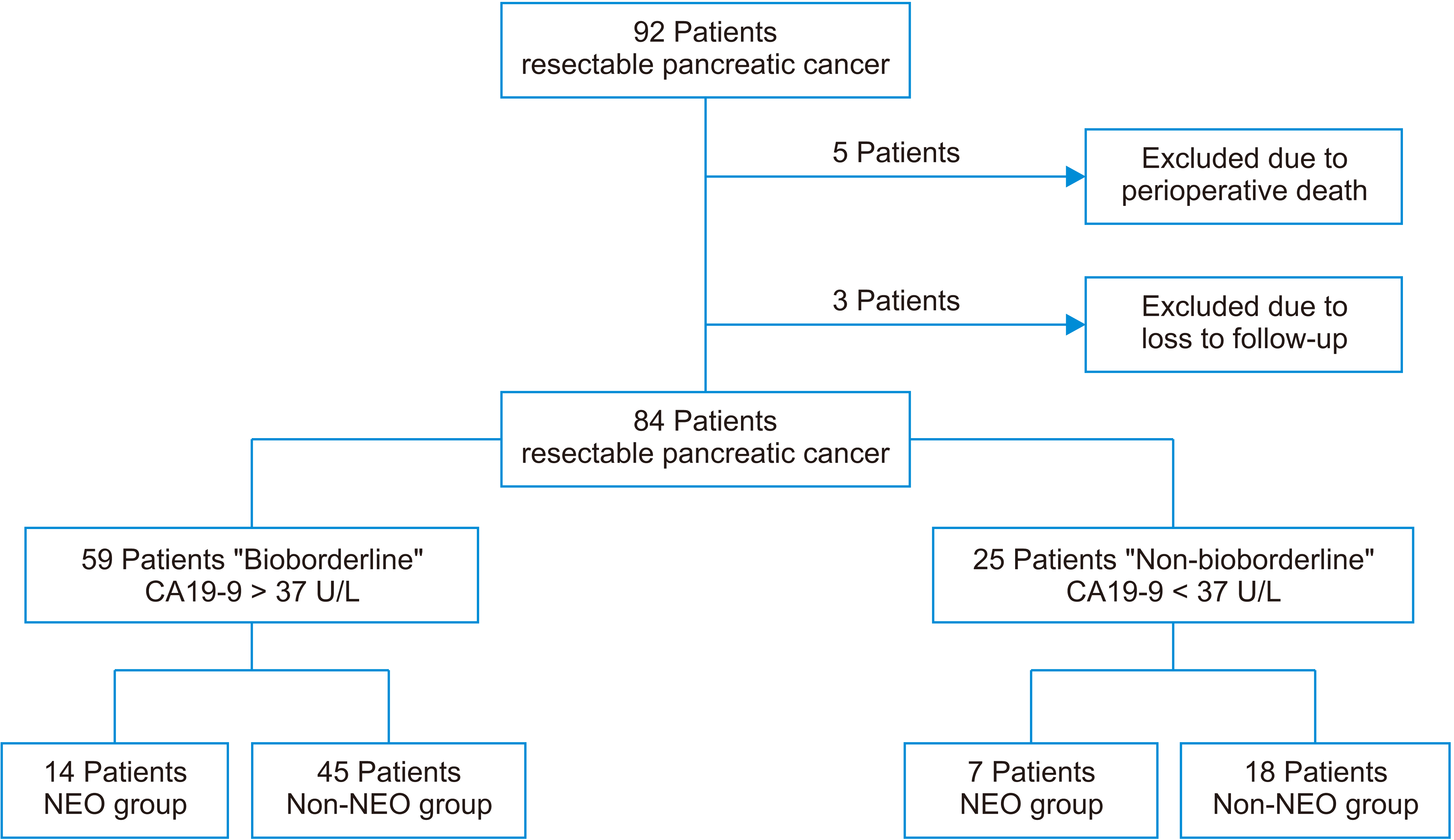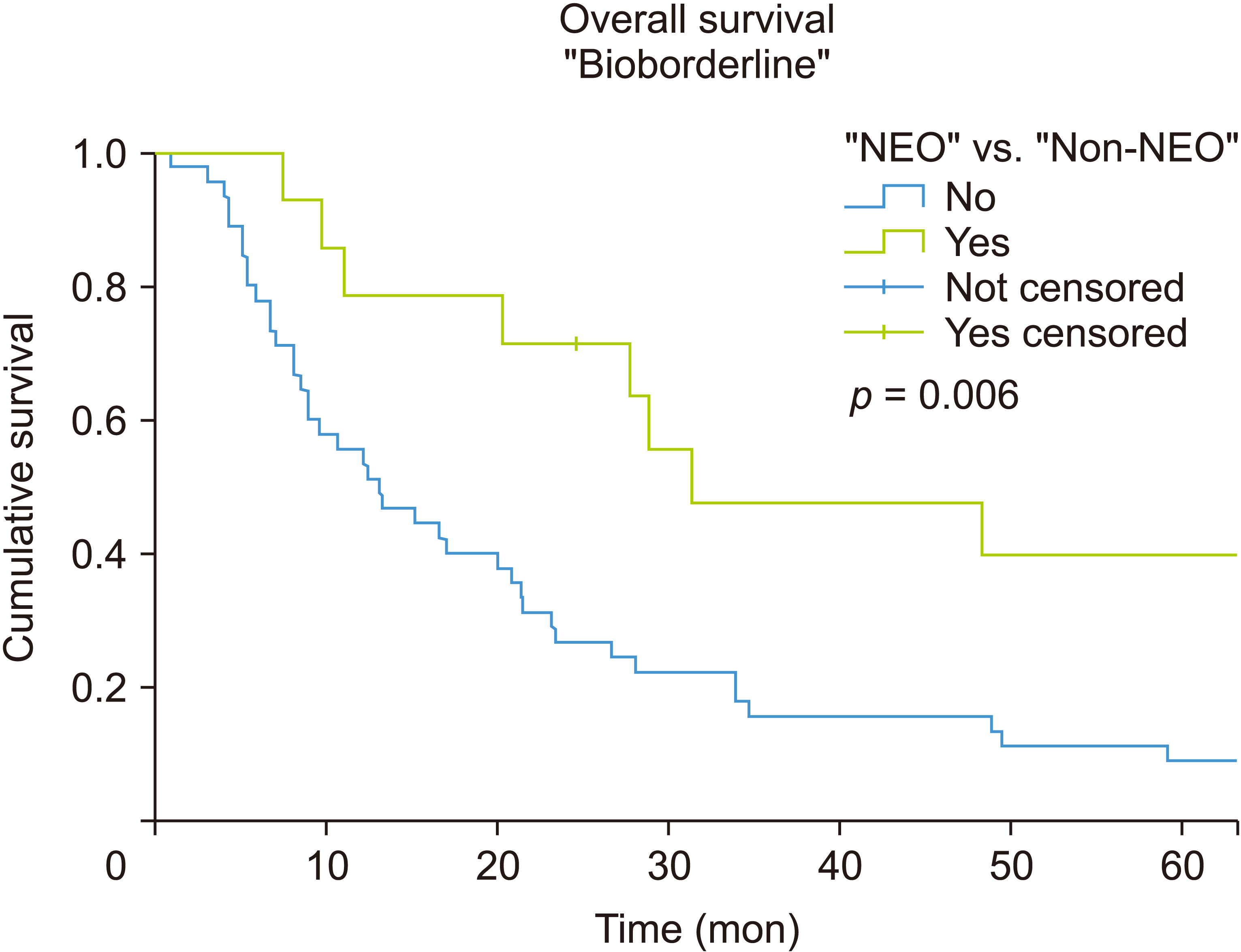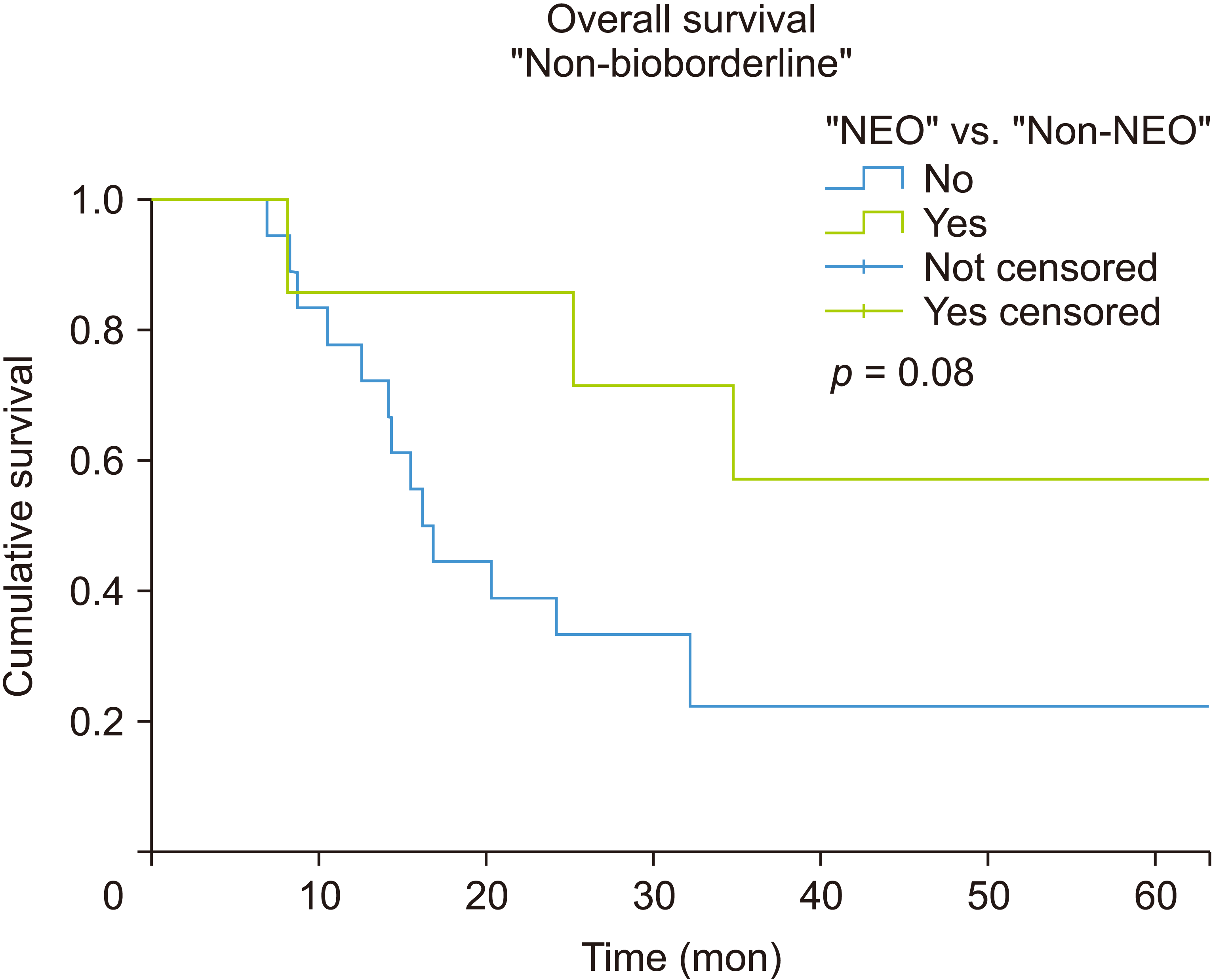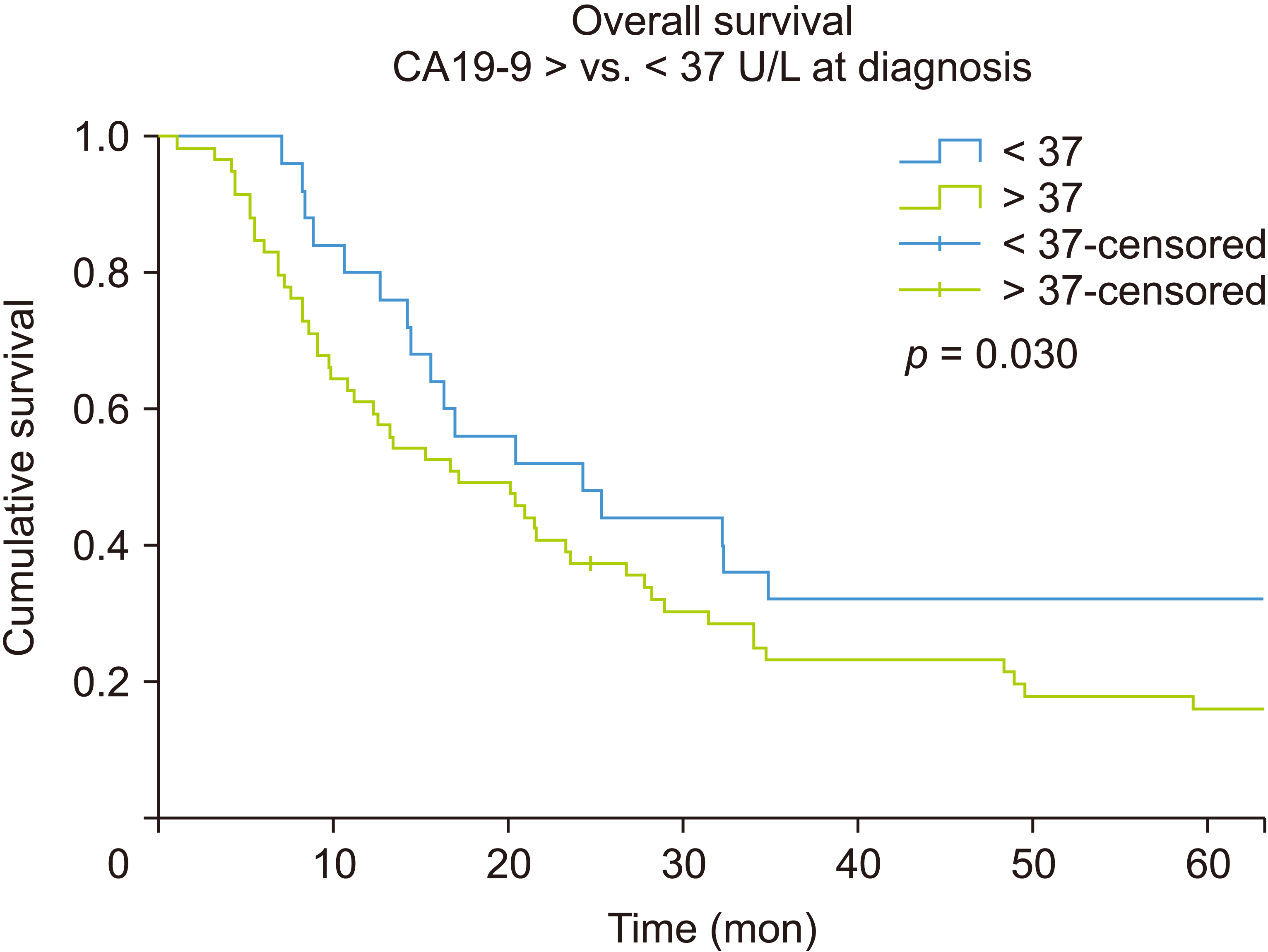1. Rahib L, Smith BD, Aizenberg R, Rosenzweig AB, Fleshman JM, Matrisian LM. 2014; Projecting cancer incidence and deaths to 2030: the unexpected burden of thyroid, liver, and pancreas cancers in the United States. Cancer Res. 74:2913–2921. Erratum in: Cancer Res 2014;74:4006. DOI:
10.1158/0008-5472.CAN-14-0155. PMID:
24840647.
2. Sohn TA, Yeo CJ, Cameron JL, Koniaris L, Kaushal S, Abrams RA, et al. 2000; Resected adenocarcinoma of the pancreas-616 patients: results, outcomes, and prognostic indicators. J Gastrointest Surg. 4:567–579. DOI:
10.1016/S1091-255X(00)80105-5. PMID:
11307091.
4. Siegel RL, Miller KD, Jemal A. 2018; Cancer statistics, 2018. CA Cancer J Clin. 68:7–30. DOI:
10.3322/caac.21442. PMID:
29313949.
5. Ducreux M, Cuhna AS, Caramella C, Hollebecque A, Burtin P, Goéré D, et al. 2015; Cancer of the pancreas: ESMO Clinical Practice Guidelines for diagnosis, treatment and follow-up. Ann Oncol. 26(Suppl 5):v56–v68. Erratum in: Ann Oncol 2017;28(Suppl 4):iv167-iv168. DOI:
10.1093/annonc/mdv295. PMID:
26314780.
6. McGuigan A, Kelly P, Turkington RC, Jones C, Coleman HG, McCain RS. 2018; Pancreatic cancer: a review of clinical diagnosis, epidemiology, treatment and outcomes. World J Gastroenterol. 24:4846–4861. DOI:
10.3748/wjg.v24.i43.4846. PMID:
30487695. PMCID:
PMC6250924.
7. Oettle H, Neuhaus P, Hochhaus A, Hartmann JT, Gellert K, Ridwelski K, et al. 2013; Adjuvant chemotherapy with gemcitabine and long-term outcomes among patients with resected pancreatic cancer: the CONKO-001 randomized trial. JAMA. 310:1473–1481. DOI:
10.1001/jama.2013.279201. PMID:
24104372.
8. Neoptolemos JP, Palmer DH, Ghaneh P, Psarelli EE, Valle JW, Halloran CM, et al. 2017; Comparison of adjuvant gemcitabine and capecitabine with gemcitabine monotherapy in patients with resected pancreatic cancer (ESPAC-4): a multicentre, open-label, randomised, phase 3 trial. Lancet. 389:1011–1024. DOI:
10.1016/S0140-6736(16)32409-6. PMID:
28129987.
10. Tienhoven GV, Versteijne E, Suker M, Groothuis KBC, Busch OR, Bonsing BA, et al. 2018; Preoperative chemoradiotherapy versus immediate surgery for resectable and borderline resectable pancreatic cancer (PREOPANC-1): a randomized, controlled, multicenter phase III trial. J Clin Oncol. 36(18 Suppl):LBA4002. DOI:
10.1200/JCO.2018.36.18_suppl.LBA4002.
12. Ferrone CR, Marchegiani G, Hong TS, Ryan DP, Deshpande V, McDonnell EI, et al. 2015; Radiological and surgical implications of neoadjuvant treatment with FOLFIRINOX for locally advanced and borderline resectable pancreatic cancer. Ann Surg. 261:12–17. DOI:
10.1097/SLA.0000000000000867. PMID:
25599322. PMCID:
PMC4349683.
13. Chun YS, Pawlik TM, Vauthey JN. 2018; 8th edition of the AJCC cancer staging manual: pancreas and hepatobiliary cancers. Ann Surg Oncol. 25:845–847. DOI:
10.1245/s10434-017-6025-x. PMID:
28752469.
14. Tamburrino D, Partelli S, Crippa S, Manzoni A, Maurizi A, Falconi M. 2014; Selection criteria in resectable pancreatic cancer: a biological and morphological approach. World J Gastroenterol. 20:11210–11215. DOI:
10.3748/wjg.v20.i32.11210. PMID:
25170205. PMCID:
PMC4145759.
15. Bergquist JR, Puig CA, Shubert CR, Groeschl RT, Habermann EB, Kendrick ML, et al. 2016; Carbohydrate antigen 19-9 elevation in anatomically resectable, early stage pancreatic cancer is independently associated with decreased overall survival and an indication for neoadjuvant therapy: a national cancer database study. J Am Coll Surg. 223:52–65. DOI:
10.1016/j.jamcollsurg.2016.02.009. PMID:
27049786.
16. Edge SB, Compton CC. 2010; The American Joint Committee on Cancer: the 7th edition of the AJCC cancer staging manual and the future of TNM. Ann Surg Oncol. 17:1471–1474. DOI:
10.1245/s10434-010-0985-4. PMID:
20180029.
17. Mattiucci GC, Morganti AG, Cellini F, Buwenge M, Casadei R, Farioli A, et al. 2019; Prognostic impact of presurgical CA19-9 level in pancreatic adenocarcinoma: a pooled analysis. Transl Oncol. 12:1–7. DOI:
10.1016/j.tranon.2018.08.017. PMID:
30237099. PMCID:
PMC6143718.
18. Williams JL, Kadera BE, Nguyen AH, Muthusamy VR, Wainberg ZA, Hines OJ, et al. 2016; CA19-9 normalization during pre-operative treatment predicts longer survival for patients with locally progressed pancreatic cancer. J Gastrointest Surg. 20:1331–1342. DOI:
10.1007/s11605-016-3149-4. PMID:
27114246. PMCID:
PMC4919020.
19. Spitz FR, Abbruzzese JL, Lee JE, Pisters PW, Lowy AM, Fenoglio CJ, et al. 1997; Preoperative and postoperative chemoradiation strategies in patients treated with pancreaticoduodenectomy for adenocarcinoma of the pancreas. J Clin Oncol. 15:928–937. DOI:
10.1200/JCO.1997.15.3.928. PMID:
9060530.
20. Calvo FA, Krengli M, Asencio JM, Serrano J, Poortmans P, Roeder F, et al. 2020; ESTRO IORT Task Force/ACROP recommendations for intraoperative radiation therapy in unresected pancreatic cancer. Radiother Oncol. 148:57–64. DOI:
10.1016/j.radonc.2020.03.040. PMID:
32339779.
21. Lambert A, Schwarz L, Borbath I, Henry A, Van Laethem JL, Malka D, et al. 2019; An update on treatment options for pancreatic adenocarcinoma. Ther Adv Med Oncol. 11:1758835919875568. DOI:
10.1177/1758835919875568. PMID:
31598142. PMCID:
PMC6763942.
22. Regine WF, Winter KA, Abrams RA, Safran H, Hoffman JP, Konski A, et al. 2008; Fluorouracil vs gemcitabine chemotherapy before and after fluorouracil-based chemoradiation following resection of pancreatic adenocarcinoma: a randomized controlled trial. JAMA. 299:1019–1026. Erratum in: JAMA 2008;299:1902. DOI:
10.1001/jama.299.9.1019. PMID:
18319412.
23. Reni M, Balzano G, Zanon S, Zerbi A, Rimassa L, Castoldi R, et al. 2018; Safety and efficacy of preoperative or postoperative chemotherapy for resectable pancreatic adenocarcinoma (PACT-15): a randomised, open-label, phase 2-3 trial. Lancet Gastroenterol Hepatol. 3:413–423. DOI:
10.1016/S2468-1253(18)30081-5. PMID:
29625841.
24. Heinrich S, Pestalozzi B, Lesurtel M, Berrevoet F, Laurent S, Delpero JR, et al. 2011; Adjuvant gemcitabine versus NEOadjuvant gemcitabine/oxaliplatin plus adjuvant gemcitabine in resectable pancreatic cancer: a randomized multicenter phase III study (NEOPAC study). BMC Cancer. 11:346. DOI:
10.1186/1471-2407-11-346. PMID:
21831266. PMCID:
PMC3176241.
25. Hozaeel W, Pauligk C, Homann N, Luley K, Kraus TW, Trojan J, et al. 2015; Randomized multicenter phase II/III study with adjuvant gemcitabine versus neoadjuvant/adjuvant FOLFIRINOX in resectable pancreatic cancer: The NEPAFOX trial. J Clin Oncol. 33(15 Suppl):TPS4152. DOI:
10.1200/jco.2015.33.15_suppl.tps4152.
26. Uhl W, Ettrich TJ, Reinacher-Schick AC, Algül H, Friess H, Kornmann M, et al. 2019; NEONAX trial: neoadjuvant plus adjuvant or only adjuvant nab-paclitaxel plus gemcitabine for resectable pancreatic cancer, a phase II study of the AIO pancreatic cancer group (AIO-PAK-0313)- safety interim analysis. J Clin Oncol. 37(15 Suppl):4128. DOI:
10.1200/JCO.2019.37.15_suppl.4128.
27. Sohal D, McDonough SL, Ahmad SA, Gandhi N, Beg MS, Wang-Gillam A, et al. 2017; SWOG S1505: a randomized phase II study of perioperative mFOLFIRINOX vs. gemcitabine/nab-paclitaxel as therapy for resectable pancreatic adenocarcinom. J Clin Oncol. 35(4 Suppl):TPS508. DOI:
10.1200/JCO.2017.35.4_suppl.TPS508.
29. Valentini V, Calvo F, Reni M, Krempien R, Sedlmayer F, Buchler MW, et al. 2009; Intra-operative radiotherapy (IORT) in pancreatic cancer: joint analysis of the ISIORT-Europe experience. Radiother Oncol. 91:54–59. DOI:
10.1016/j.radonc.2008.07.020. PMID:
18762346.
30. Li Y, Feng Q, Jin J, Shi S, Zhang Z, Che X, et al. 2019; Experts' consensus on intraoperative radiotherapy for pancreatic cancer. Cancer Lett. 449:1–7. DOI:
10.1016/j.canlet.2019.01.038. PMID:
30771429.
31. Calvo FA, Sole CV, Atahualpa F, Lozano MA, Gomez-Espi M, Calin A, et al. 2013; Chemoradiation for resected pancreatic adenocarcinoma with or without intraoperative radiation therapy boost: long-term outcomes. Pancreatology. 13:576–582. DOI:
10.1016/j.pan.2013.09.002. PMID:
24280572.
32. Ogawa K, Ito Y, Karasawa K, Ogawa Y, Onishi H, Kazumoto T, et al. 2010; Patterns of radiotherapy practice for pancreatic cancer in Japan: results of the Japanese Radiation Oncology Study Group (JROSG) survey. Int J Radiat Oncol Biol Phys. 77:743–750. DOI:
10.1016/j.ijrobp.2009.05.063. PMID:
19879060.
33. Versteijne E, van Dam JL, Suker M, Janssen QP, Groothuis K, Akkermans-Vogelaar JM, et al. 2022; Neoadjuvant chemoradiotherapy versus upfront surgery for resectable and borderline resectable pancreatic cancer: long-term results of the dutch randomized PREOPANC trial. J Clin Oncol. 40:1220–1230. DOI:
10.1200/JCO.21.02233. PMID:
35084987.
34. Taboada AGM, Lominchar PL, Roman LM, García-Alfonso P, Martin AJM, Rodriguez JAB, et al. 2021; Advances in neoadjuvant therapy for resectable pancreatic cancer over the past two decades. Ann Hepatobiliary Pancreat Surg. 25:179–191. DOI:
10.14701/ahbps.2021.25.2.179. PMID:
34053920. PMCID:
PMC8180394.







 PDF
PDF Citation
Citation Print
Print




 XML Download
XML Download